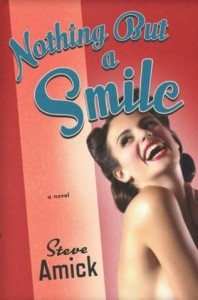 One of the reasons I started this blog was to spotlight writers/artists/actors who may not be household names yet but I feel deserve attention. Last month, I received Steve Amick‘s book Nothing But a Smile and was immediately drawn into the 1940s world of Wink, an illustrator who gets sent home to Chicago after injuring his drawing hand in WWII, and Sal, Wink’s war buddy’s wife with whom he collaborates in producing “girlie pictures” to pay the bills. Though Sal uses herself and her best friend Reenie as models in the semi-nude pinups, an almost-chaste yet aching friendship slowly develops between Wink and Sal. Amick’s wicked humor and eye for period detail makes this a sexy, poignant story of love, friendship, and resilience during troubled times.
One of the reasons I started this blog was to spotlight writers/artists/actors who may not be household names yet but I feel deserve attention. Last month, I received Steve Amick‘s book Nothing But a Smile and was immediately drawn into the 1940s world of Wink, an illustrator who gets sent home to Chicago after injuring his drawing hand in WWII, and Sal, Wink’s war buddy’s wife with whom he collaborates in producing “girlie pictures” to pay the bills. Though Sal uses herself and her best friend Reenie as models in the semi-nude pinups, an almost-chaste yet aching friendship slowly develops between Wink and Sal. Amick’s wicked humor and eye for period detail makes this a sexy, poignant story of love, friendship, and resilience during troubled times.
Amick kindly consented to an e-mail interview with me, where he talks about his inspiration and tedious, labor-intensive task of researching girlie magazines. I’ll be publishing this interview in two parts so be sure and come back for the conclusion.
PCN: What inspired you to write a sweet love story about people who produced girlie pictures?
Steve Amick: I didn’t have that specific outcome in mind. I try to just place characters in a moment of conflict and have them find their way, and these characters quickly presented themselves as two people with certain very likable personalities who would logically find each other very likable and I just stepped out of the way and let it happen. But that being said, I am drawn to characters that make you care about them despite their environment or what they do. It’s a little too easy to make people care about heartthrob Dudley Dorights who volunteer for Doctors Without Borders. Generating empathy for characters we would normally not get to know—or want to know—in real life is sort of, I feel, part of the assignment as a writer. Going into the unsavory or weird places and finding common ground and a sort of universal light. And yes, I guess I do enjoy irony and contrast a lot and challenging people’s own sense of what they care about and don’t care about.
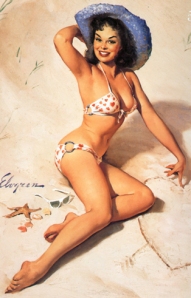 The inspiration for this one was very specific, though. I didn’t have the two characters or the setting or anything: I had a cover image and a title. I’d been talking to my father-in-law, who was a former commercial illustrator and painter in Chicago, about our mutual admiration for Gil Elvgren, arguably the most talented painter to ever produce pinup calendar art.
The inspiration for this one was very specific, though. I didn’t have the two characters or the setting or anything: I had a cover image and a title. I’d been talking to my father-in-law, who was a former commercial illustrator and painter in Chicago, about our mutual admiration for Gil Elvgren, arguably the most talented painter to ever produce pinup calendar art.
It was the first day of the year and I went online to look for a new calendar and came across a new 2007 calendar featuring old, very hokey, very amateurish semi-nude girly photos. The one on the cover was so strangely fresh-faced and beaming and yet so homemade, with a cartoon sun painted on the brick wall behind her, that sort of as a joke or a challenge or a future idea, I grabbed the image and downloaded it into a file, making a cover page titled “The Girlies: A Novel.”
I had no idea for a story, but the next day, without trying to return to it, ideas started coming as to what that story would be that would fit that cover…So I wrote five pages a day for two months and at the end of it, had a solid first draft…I like to trick readers into caring about people and subjects they might otherwise think aren’t their “cup of tea,” especially readers who say things like “not my cup of tea.”
PCN: Your descriptions of the pictorials were incredibly detailed and vivid. How much, um, research did you have to do?
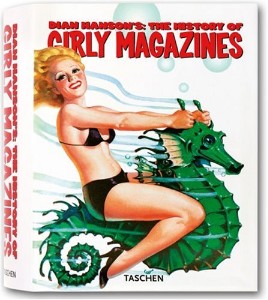 SA: Years and years, of course. Since before my voice changed. I don’t have a photographic memory, but it is pretty close. There is one reference book I looked at, The History of Girly Magazines (Taschen Books), that breaks down the genre into eras, and there are examples of some ridiculous photo shoots—especially the non-nude ones—with very strange and corny scenarios. None of them ended up in the book, but they inspired the cheesy arts-and-crafts approach to the set dressing. Things made of cardboard, hokey costumes, cobbled together props. And the over-the-top facial expressions and pun-heavy copy.
SA: Years and years, of course. Since before my voice changed. I don’t have a photographic memory, but it is pretty close. There is one reference book I looked at, The History of Girly Magazines (Taschen Books), that breaks down the genre into eras, and there are examples of some ridiculous photo shoots—especially the non-nude ones—with very strange and corny scenarios. None of them ended up in the book, but they inspired the cheesy arts-and-crafts approach to the set dressing. Things made of cardboard, hokey costumes, cobbled together props. And the over-the-top facial expressions and pun-heavy copy.
PCN: Do you have an interest in photography? What kind of camera do you use? The way the Argus was described in the book is akin to how some guys talk about their cars.
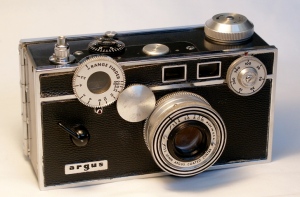 SA: I live near the original Argus Camera company. I mean, I can walk there from my house. It’s now an office building that houses a small museum dedicated to Argus. We had the after-party for my book launch there, with a jazz combo and cheesecake (the edible kind).
SA: I live near the original Argus Camera company. I mean, I can walk there from my house. It’s now an office building that houses a small museum dedicated to Argus. We had the after-party for my book launch there, with a jazz combo and cheesecake (the edible kind).
When I paused in writing to figure out what Wink would be using, the slightest bit of research reminded me what it had to be. The Argus C-3 really opened up 35 mm photography to the general public, the GIs used it and it was made here in Ann Arbor. The coincidence was too great so I went with it.
…As a teenager, I was more into making super 8 movies—both Claymation and ambitious epics with my friends. My first camera was one of those wooden Fisher-Price toys, with the four seasons on the flash cube. The second was a camera shaped like Mickey Mouse’s head. You held the whole thing up by the ears to your head and basically looked like you’d replaced your head with Mickey’s and the aperture was through his nose. (That thing must be worth something at this point.) We had some old German camera when I was growing up that we used for camera classes and stuff, but I think even that stopped working eventually. I just monkey around with point-and-shoots now, but I do not own a digital.
PCN: The photo Wink took of Keeney, the war veteran, turned out to have a completely different backstory than what Wink had assumed. Have you ever looked at an iconic photo and had an alternate theory about what was really happening when the picture was snapped?
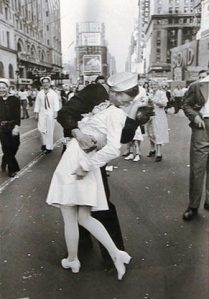 SA: I do kind of wonder if, right after that photo of the sailor bending the girl backwards—Alfred Eisenstaedt’s “V-J Day in Times Square”— if she didn’t haul back and slap the crap out of him. It’s possible she pressed charges. Wouldn’t it just be so great if someone discovered there was an entire roll of film after that frame, showing a burly husband appearing and throttling the guy?
SA: I do kind of wonder if, right after that photo of the sailor bending the girl backwards—Alfred Eisenstaedt’s “V-J Day in Times Square”— if she didn’t haul back and slap the crap out of him. It’s possible she pressed charges. Wouldn’t it just be so great if someone discovered there was an entire roll of film after that frame, showing a burly husband appearing and throttling the guy?
PCN: I was thinking of that photo when I wrote this question! And yes, it’d be great to see the “outtakes” of what happened right afterwards.
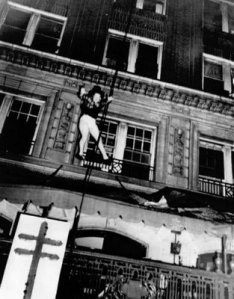 SA: What’s interesting, too, is that when I dug around to find out what photo actually won the Pulitzer [in 1947] that supposedly beat out Wink’s fictional photo, I found that the amateur shot [by Arnold Hardy] of a woman falling from an apartment fire continues, to this day, to be mislabeled as “to her death,” when in reality she died several decades later. She recuperated—that whole business in the book is true. So the question is, was the photo really that effective and moving, or do people just remember the headline or the caption or the idea of the image? In a way, come to think of it, this entire novel was written as an imagining of a photo for which I had no real information.
SA: What’s interesting, too, is that when I dug around to find out what photo actually won the Pulitzer [in 1947] that supposedly beat out Wink’s fictional photo, I found that the amateur shot [by Arnold Hardy] of a woman falling from an apartment fire continues, to this day, to be mislabeled as “to her death,” when in reality she died several decades later. She recuperated—that whole business in the book is true. So the question is, was the photo really that effective and moving, or do people just remember the headline or the caption or the idea of the image? In a way, come to think of it, this entire novel was written as an imagining of a photo for which I had no real information.
PCN: Much has changed in 60 years but do you think there are any similarities between the current climate and what America was like during WWII?
SA: I hadn’t planned on there being a similarity when I wrote this in early ’07, but I’m hearing from so many people that my book is “timely” because of the economy that I’m starting to believe there maybe is a connection. Yes, people are now looking at prioritizing and also their own sense of identity—what’s at the heart of who they are, especially in terms of jobs and lifestyle, but I think the real point of comparison—and it’s perhaps too soon to tell about this—is if there develops the same sense of self-sacrifice for the common good seen on the homefront during WWII.
I do know that at my house this spring, we are ripping up the front yard and building a victory garden. I’m not kidding. I figure, if nothing else, it’s a good example for our toddler about where food comes from, and working at things, and simple pleasures and all that good old-fashioned stuff. Plus, with a chicken wire fence out there, he won’t be able to run out into traffic. Win-win.
PCN: That’s so cool. What goes into a victory garden?
SA: With a two-year-old, mostly things he won’t really want to jump on and crush…I asked what he wants and he seems convinced we can grow Cheerios. I think the traditional answer is things that can be canned, to sustain you longer than the garden’s season, and things that can be replanted throughout the season, but I’m not quite ready to take on canning and frankly we’ll be lucky if we get one batch of food out of it. Probably, it will become a very large sandbox, but that would be okay, too.
Click here for the conclusion of this interview, in which Amick teases his next book and speculates about who would play the leads if Nothing But a Smile were made into a movie.






12 Comments
ShelleyP
April 12, 2009 at 9:33 pmLooking forward to Part 2, PCN. Your questions get away from the run-of-the-mill and lead to some great insights into the creative process and how it can come about. So interesting!
popculturenerd
April 13, 2009 at 11:22 amThanks, ShelleyP. I try to ask non-boring questions but it’s really up to my interview subjects to make the read interesting and I think Steve Amick definitely did.
READER#9
April 13, 2009 at 9:28 amAmick seems like a helluva guy. Someone you sit down and have a beer with. I ordinarily wouldn’t stop and give this book a second look, mainly because my girlfriend would smack me in public, but I’ll take a look.
ARB
April 13, 2009 at 9:33 amProbably have to read it in a dark closet with a flashlight! Great interview, PCN.
popculturenerd
April 13, 2009 at 11:36 amNo, read it on a park bench during day time with a bucket of chicken!
ARB
April 13, 2009 at 11:38 amA Seinfeld reference? (LOL!)
popculturenerd
April 13, 2009 at 11:45 amNo, Friends! Remember when Rachel accused Joey of taking nude photos of her and Monica then looking at them while eating a bucket of chicken?
ARB
April 13, 2009 at 6:04 pmThat’s right! Dang, I feel silly!
EireGo
April 13, 2009 at 10:55 amGreat cover! Nice to know there’s a decent plot on the pages as well. (lol)
ScriptPimp
April 13, 2009 at 11:17 amSteve Amick is funny. I’ll be back for the second half.
BizMan5
April 13, 2009 at 11:31 amI’ll be back for round 2 as well.
Lizabeth Ann
April 14, 2009 at 12:46 pmThanks, PCN, for your Steve Amick interview. Takes me back, lifts me up at the same time. Caused me, even, to open a chest of WWII family photographs, some surely made with an old argus I have here. Wonderful!